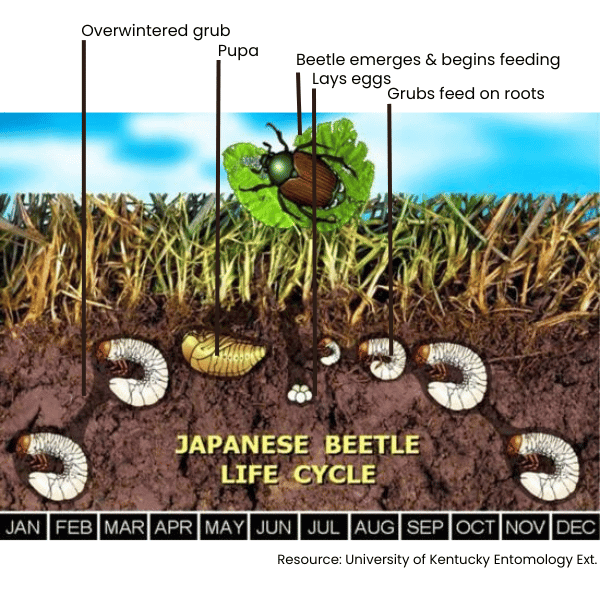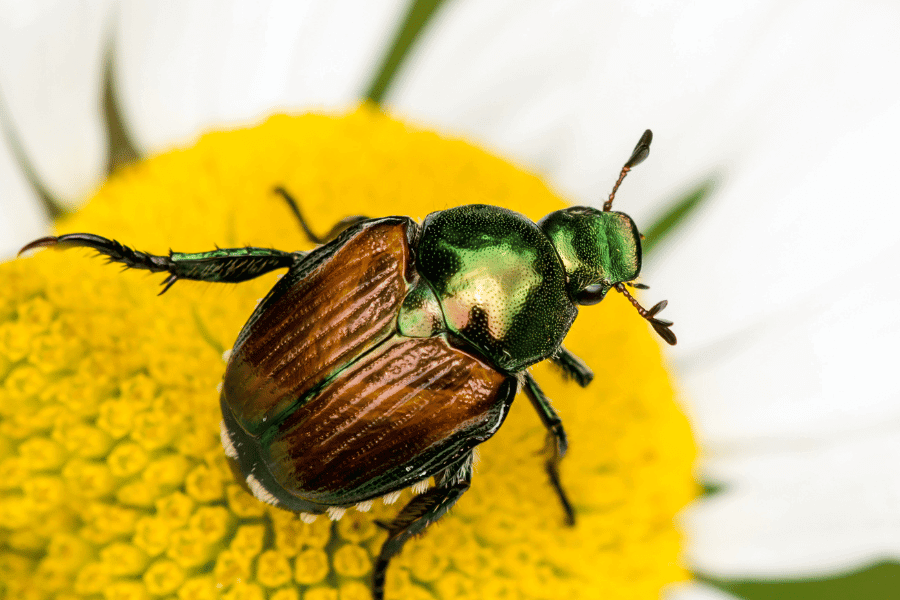Japanese beetles (Popillia japonica) are a highly destructive and invasive species that pose a significant threat to gardens and landscapes across our regions. Originating from Japan, these beetles were accidentally introduced to the United States in the early 20th century and have since become a major nuisance for gardeners in North America. Known for their voracious appetite, Japanese beetles can quickly decimate plants, flowers, and trees if left unchecked. Let’s explore the behavior, lifecycle, and effective strategies to combat Japanese beetles and safeguard your garden.
Identification & Behaviour
Japanese beetles are small insects, measuring about half an inch in length, with metallic green bodies and copper-brown wings. They are easily recognizable due to their unique appearance and tend to congregate in large groups. Japanese beetles are most active during the summer months, typically from June to August, and are primarily active during the daytime.
These beetles have a diverse palate and feed on over 300 different plant species, making them a significant threat to a wide range of garden plants. They are particularly attracted to roses, grapes, linden trees, raspberries, and many other ornamental plants and fruits. Japanese beetles feed on the leaves, flowers, and fruits of their host plants, leaving behind skeletonized foliage and often causing severe damage.
Lifecycle
Understanding the lifecycle of Japanese beetles is crucial in developing effective control strategies. The adult beetles emerge from the ground in early summer, usually in late June or early July, and start feeding immediately. The beetles mate, and the females lay their eggs in the soil during this time. The eggs hatch into small, white grubs, which then feed on the roots of grasses and other plants throughout late summer and fall. The grubs overwinter in the soil, remaining dormant until spring when they resume feeding. As the weather warms, the grubs pupate and transform into adult beetles, emerging from the ground to begin the cycle anew. This lifecycle spans a year, and each generation can cause significant damage to your garden.


Preferred Plants
While they have a wide range of host plants, some of the most commonly affected plants by Japanese beetle damage include:
- Roses: Japanese beetles are particularly fond of roses and can quickly defoliate the plants. They feed on the leaves, leaving behind a lacy skeletonized appearance.
- Grapes: Both the foliage and fruits of grapevines are susceptible to Japanese beetle feeding. They chew on the leaves, often leaving only the veins behind, and can damage developing grapes, causing them to become scarred or even drop prematurely.
- Fruit Trees: Japanese beetles can cause harm to various fruit trees, including apple, cherry, peach, and plum. They chew on the leaves, leading to skeletonized foliage, and can also attack the fruits.
- Linden Trees: Linden or basswood trees are highly attractive to Japanese beetles. The beetles can defoliate the trees, leaving them vulnerable to stress and other diseases.
- Birch Trees Japanese beetles can damage the leaves of birch trees, creating a lace-like pattern as they consume the foliage. This can weaken the tree’s overall health if the infestation is severe.
- Hibiscus: Japanese beetles can inflict damage on both perennial and annual varieties of hibiscus. They consume the leaves, flowers, and buds, often resulting in unsightly foliage and diminished blooming.
- Corn: While primarily known for their damage to ornamental plants, Japanese beetles can also be problematic for agricultural crops. They can attack corn plants, feeding on the silks and tassels, which can interfere with pollination and affect crop yield.
- Beans: Japanese beetles can cause significant damage to bean plants, including green beans and soybeans. They eat the leaves, often leaving behind only the veins, and can affect the plant’s ability to photosynthesize.
- Ornamental Shrubs: Japanese beetles can target various ornamental shrubs, such as hydrangeas, azaleas, and viburnums. They chew on the foliage, causing leaves to become skeletonized and diminishing the overall aesthetic appeal of the plants.
It’s important to note that while these plants are commonly affected by Japanese beetles, the infestation severity can vary depending on the region and specific circumstances. Gardeners often employ various control measures to manage Japanese beetle populations and minimize damage to their plants.
Japanese beetles can also cause damage to a variety of perennial plants. Here are some perennials commonly affected by Japanese beetle damage:
- Daylilies: Japanese beetles often feed on daylilies, leaving behind skeletonized leaves and sometimes consuming the flowers as well.
- Hostas: Hostas are a favorite target of Japanese beetles. They can defoliate the plants, leaving only the leaf veins behind, and cause significant damage to the foliage.
- Coneflowers: Japanese beetles are attracted to the flowers of coneflowers and can feed on the petals and pollen. This can result in disfigured blooms and reduce the overall attractiveness of the plant.
- Black-eyed Susans: These bright yellow flowers are highly attractive to Japanese beetles. The beetles can chew on the leaves and petals, affecting the plant’s appearance.
- Bee balm: Japanese beetles can damage the foliage and flowers of bee balm plants. They consume the leaves, leaving behind a lace-like pattern, and may also eat the petals of the flowers.
- Phlox: Phlox plants are susceptible to Japanese beetle feeding. The beetles can consume the leaves and flowers, leading to defoliation and damage to the blooms.
- Sedums: Sedum plants are not immune to Japanese beetle damage. The beetles can chew on the leaves, resulting in unsightly foliage.
- Peonies: Japanese beetles can cause harm to peony plants by feeding on the leaves and flowers. They can leave behind skeletonized foliage and may also damage the petals.
- Irises: While not their preferred food source, Japanese beetles can still cause damage to iris plants. They may consume the leaves and can chew on the flower petals, affecting the overall appearance.
- Delphiniums: Delphiniums are another perennial susceptible to Japanese beetle damage. The beetles can eat the leaves and flowers, leading to defoliation and diminished blooms.
Controls
While completely eradicating Japanese beetles from your garden may be challenging, several strategies can help you control their population and minimize the damage they cause:
- Handpicking: Check your plants regularly and handpick the beetles, dropping them into a bucket of soapy water. This method is most effective in the morning when the beetles are less active.
- Companion Planting: Intercropping certain plants can help deter Japanese beetles. They tend to avoid strongly scented plants such as garlic, catnip, chives, and marigolds. Consider planting these as companions to your vulnerable plants.
- Insecticides: If the infestation is severe and other methods have proven ineffective, insecticides labeled for Japanese beetle control can be used. Follow the instructions carefully and consider less toxic options first.
Pheromone Traps
Using pheromone traps is one method that can be employed to control Japanese beetles in a targeted manner. Pheromone traps are designed to attract and trap adult beetles by using a synthetic sex pheromone that mimics the scent released by female beetles. Here’s how you can use pheromone traps for Japanese beetle control:
- Placement: Set up the traps in your garden or affected areas in late spring or early summer when adult Japanese beetles are active. Place the traps away from desirable plants to lure the beetles away from your prized flowers and vegetables.
- Follow instructions: Read and follow the manufacturer’s instructions carefully when setting up the traps. Each trap may have specific guidelines regarding placement, height, and distance from plants.
- Timing: Set up the traps early in the morning when the beetles are typically less active. Empty and replace the traps daily or every few days to ensure they remain effective.
- Regular maintenance: Monitor the traps regularly and empty them to prevent the beetles from escaping or attracting even more beetles to the area. Dispose of the trapped beetles by either drowning them in soapy water or placing them in a sealed bag before discarding.
- Multiple traps: If you have a large garden or a significant Japanese beetle infestation, you may need to use multiple traps strategically placed throughout the area to increase effectiveness.
Watch our video on how to assemble a pheromone trap here!
It’s important to note that while pheromone traps can capture a significant number of adult Japanese beetles, they may not eliminate the entire population. These traps work best as part of an integrated pest management approach that combines various control methods. Other techniques to consider include handpicking beetles, using insecticidal sprays (preferably organic and targeted), employing physical barriers like floating row covers, and cultivating plants that are less attractive to Japanese beetles.
Keep in mind that pheromone traps can attract beetles from neighboring areas, so it’s essential to coordinate with your neighbors if they also have Japanese beetle problems. By combining various control methods and staying vigilant, you can help reduce the population of Japanese beetles and protect your plants.
Japanese beetles are a significant challenge for gardeners, but with proper knowledge and proactive measures, you can protect your garden from their devastating impact. Regular monitoring, handpicking, and implementing preventive strategies such as companion planting and traps can help deter these invasive pests. By adopting a multi-pronged approach and considering environmentally friendly options, you can reduce the population of Japanese beetles and preserve the beauty and health of your garden.




